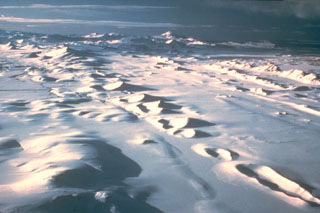Report on Bardarbunga (Iceland) — 13 August-19 August 2014
Smithsonian Institution / US Geological Survey
Weekly Volcanic Activity Report, 13 August-19 August 2014
Managing Editor: Sally Sennert.
Please cite this report as:
Global Volcanism Program, 2014. Report on Bardarbunga (Iceland) (Sennert, S, ed.). Weekly Volcanic Activity Report, 13 August-19 August 2014. Smithsonian Institution and US Geological Survey.
Bardarbunga
Iceland
64.633°N, 17.516°W; summit elev. 2000 m
All times are local (unless otherwise noted)
During 13-19 August the Icelandic Met Office reported increased seismic activity at Bárdarbunga volcano. On 16 August more than 200 earthquakes were reported under the NW Vatnajökull ice cap, and GPS stations have shown an increasing signal upward and away from the volcano since early June 2014. On 16 August the Aviation Color code was increased to Yellow. On 18 August the Icelandic Met Office reported an earthquake swarm to the E and another to the N of Bárdarbunga. A M4 earthquake was recorded that was the strongest in the region since 1996. By 18 August there had been 2,600 earthquakes detected at the volcano; earthquake locations from N and E swarms had been migrating NE, but in the evening activity of the N swarm had decreased significantly. That same day the Aviation Color code was raised to Orange.
Geological Summary. The large central volcano of Bárðarbunga lies beneath the NW part of the Vatnajökull icecap, NW of Grímsvötn volcano, and contains a subglacial 700-m-deep caldera. Related fissure systems include the Veidivötn and Trollagigar fissures, which extend about 100 km SW to near Torfajökull volcano and 50 km NE to near Askja volcano, respectively. Voluminous fissure eruptions, including one at Thjorsarhraun, which produced the largest known Holocene lava flow on Earth with a volume of more than 21 km3, have occurred throughout the Holocene into historical time from the Veidivötn fissure system. The last major eruption of Veidivötn, in 1477, also produced a large tephra deposit. The subglacial Loki-Fögrufjöll volcanic system to the SW is also part of the Bárðarbunga volcanic system and contains two subglacial ridges extending from the largely subglacial Hamarinn central volcano; the Loki ridge trends to the NE and the Fögrufjöll ridge to the SW. Jökulhlaups (glacier-outburst floods) from eruptions at Bárðarbunga potentially affect drainages in all directions.

